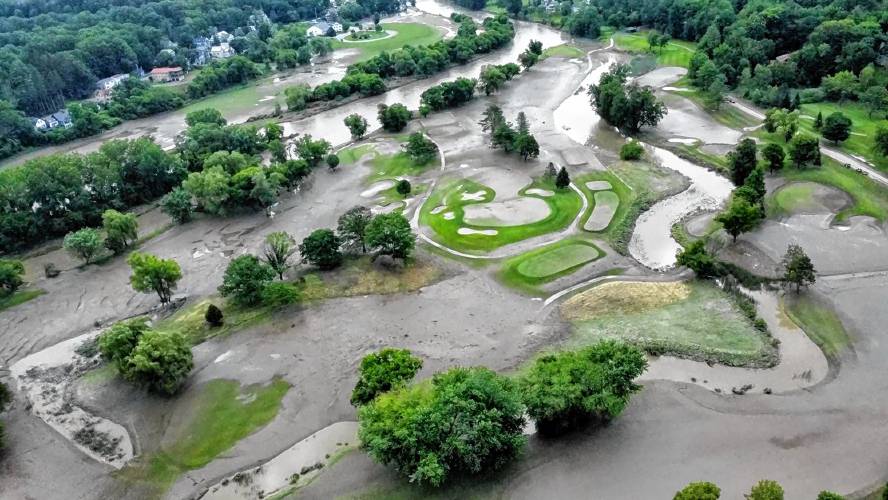Upper Valley golf courses recovering from damage inflicted by flooding
| Published: 07-19-2023 10:10 AM |
A pair of local golf courses were affected during last week’s rain and flooding in the White River Valley, with varying consequences.
Jeff Barry, owner of Randolph’s public Montague Golf Club, said his business has reopened its first nine holes but is “weeks away” from being able to do so with the rest of the course.
At the private Quechee Club, which features two courses, Highland and Lakeland, the Highland course’s last nine holes have reopened but its first nine are on a similar schedule with Montague. The Lakeland course is not expected to reopen until next year, said general manager Brian Kelley.
“Nobody could have predicted the amount of rain that fell in such a short time,” said Kelley, whose course was also damaged in 2011 by Tropical Storm Irene. “The difference was there was no wind this time, so we had no tree damage.
“We’re very fortunate that flooding didn’t affect the clubhouse, so our outdoor and indoor pools, restaurant and racket courts are all back running. But it’s all hands on deck for golf course restoration.”
One of Kelley’s major concerns is the bridge at one end of the property that’s used by pedestrians and golf carts. Engineers brought in to examine the span discovered structural damage at one end. Kelley said the club is seeking a temporary fix that would support the weight of needed machinery.
Kelley said his week immediately after the storm was mostly sleepless, with assessments, problem-solving and solutions galore. An agronomy company has been brought in to help the club handle silt deposits ranging from a dusting to two feet deep. Hand shoveling and power brooms are used to clear the greens, while backhoes and bulldozers are needed for some fairways.
“There’s mud and muck that’s heavy and is just baking the grass under it, but it’s hard to remove it with regular, manual labor,” said Kelley, who was hired in July 2020 and who has roughly a half-dozen maintenance workers whose experience during Irene has been valuable. “There’s also nasty bacteria in it, oils and stuff from the farms upriver.”
Article continues after...
Yesterday's Most Read Articles
Kelley said divers entered the property’s Lake Pinneo and ensured the pipes connecting it with the irrigation system were clear. That will allow use of sprinklers to help clear and reinvigorate the grass. Testing of the lake water revealed problematic levels of contamination, however, so weekly testing is required before it’s deemed safe for recreation.
“That’s a hard one to peg because the water is still murky and we don’t know exactly when it will settle,” Kelley said.
Quechee’s Highland Course is more elevated and nine holes were opened for play Monday, although there are limited tee times. Once the bridge is deemed safe, all 18 Highland holes should be playable, Kelley said. However, the lower-lying Lakeland course will need months of work to be restored.
“It meanders around the river and the lake and was completely under water,” the general manager said. “Most of the water receded quickly, but the problem is the debris it left behind. We need time for reseeding and germination.”
Barry, who has owned Montague for less than a year, said three acres of land comprising virtually all of the 16th hole was swept away. It was a location where plans to reinforce the river bank had already been made following the erosion of 10-15 feet this spring.
“We were working with the state and civil engineers and waiting for permits,” Barry said. “It’s a field in a flood zone, so you expect it. Holes 10, 16 and 18 are always going to be problems.”
The 16th hole had a 370-foot, par-4 configuration and plans are for it to become a 168-yard, par-3. Culverts are being replaced and cart paths rebuilt. Barry said the course escaped more serious damage because it was remodeled after Irene with a drainage channel between the 10th ad 18th fairways.
“We’re in a lot better shape than the pictures look,” he said. “And it’s golf. It’s not like losing houses or a life-and-death situation.”
Tris Wykes can be reached at twykes@vnews.com.



 Young Oxbow baseball team struggles, but coach still finds joy in teaching the game
Young Oxbow baseball team struggles, but coach still finds joy in teaching the game Local Roundup: Hartford tops Woodstock in close girls lacrosse contest
Local Roundup: Hartford tops Woodstock in close girls lacrosse contest Hurricanes earn 10-9 victory over U-32 in girls lacrosse
Hurricanes earn 10-9 victory over U-32 in girls lacrosse Stevens, Newport baseball split high-scoring games
Stevens, Newport baseball split high-scoring games
